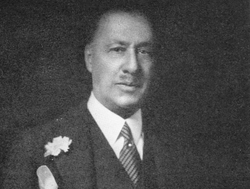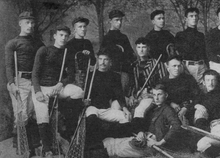
J. Frederick Talcott
James Frederick Talcott (September 14, 1866 - February 6, 1944) was the oldest son of James Talcott and the successor of the successful New York company, James Talcott Inc., manufacturer of textile agents.
Life and Death[]
James Frederick Talcott was born on September 14, 1866 in New York City to James Talcott and Henrietta Francis. James and J. Frederick were worlds apart in disposition, but remained close nonetheless. The father was stern in demeanor and Puritan in his hobbies while J. Frederick loved society, sports, philosophy, and the arts. He was sent to Princeton to study, where he immersed himself in educaion and athletics, as well as a large circle of friends. Indeed, he was a member of the champion Princeton lacross team the year he received his degree - 1888. At the family summer home in Rumson, New Jersey, a fashionable summer retreat that attracted New York's financiers, J. Frederick became enamored with a young woman from a neighboring house. She was Frank Vanderbilt Crawford, named after her mother, whose father had made a promise to name his first child after a dear friend, and kept his word even though the child was a girl. The younger Frank and J. Frederick were engaged in 1889 and married in October 1890.

J. Frederick (far left) was a member of the champion Princeton lacrosse team in 1888.
After earning his Master's from Princeton in 1890, J. Frederick was still drawn to academia. He traveled with his new wife to England, where he studied theology at Oxford and avidly attended religious debating events and sermons. From England, the young couple took tours of Egypt and Palestine, and then embarked on an impromptu 11-day horseback caravan into Syria. So began a lifetime of world travels. Returning to Europe, the couple spent another year in Berlin where J. Frederick continued to study. Back in New York, J. Frederick enrolled in the Union Theological seminary. His parents feared that he was in a bed of heretical teaching but it made sense to J. Frederick. Always an independent thinker, he had never been impressed with Sunday school, and never sent his own children. He preferred to instruct them on a rolling scroll contraption of his own making that covered the Bible from Creation to Revelations. He left Presbyterianism to become an Episcopalian and was ordained a minister in 1893. That same year, J. Frederick bought a house in one of the northernmost residential parts of the city - on W 87th Street - less than a block from Central Park. J. Frederick and Frank's four children would be born there.
J. Frederick enters the business[]
Like his father, J. Frederick was involved in mission work in the tenements. After being ordained, he took a position at St. Bartholomew's where he set up an employment bureau for the church's mission. His five-year tenure was a great success, sparking an interest in business. In 1879, J. Frederick joined his father's business full time, also becoming a director of the American Hosiery Co. It was the turn of the century and factoring was changing again. Ledger books gave way to adding machines, the telephone had become a fixture in business, electric lights outstripped gas lamps, and top hats and frock coats were set aside for business suits (with the exception of his father). His father put J. Frederick in charge of shifting the staff and the business to match the shifting times. The company drafted what would become the Factors Lien Act, which laid the groundwork for the growth in the factoring business. As a result, factoring drew even closer to banking, no longer handing merchandise and instead providing capital loans to the mills and factories.
J. Frederick's wife, Frank, fell ill in 1914 at the start of World War I. She died in March 1915. Their sons were at Harvard, but their daughters were still in high school. J. Frederick came home for lunch each day to spend time with them. In 1915, the business incorporated to better represent its textile interests and became James Talcott, Inc. Moreover, in 1916, J. Frederick's father, James Talcott, died at the age of 86, surrounded by family and friends. In 1917, J. Frederick married Louise Simmons, the daughter of Florida orange orchard owners, in a small ceremony.
After James's death, J. Frederick took on the full responsibilities of the business. Following his father's example, he sought the council of his mother, Henrietta, who was invaluable during the transition. At the end of World War I, J. Frederick's sons returned from the Navy and he brought them on in 1918, giving a primary role to his eldest son. J. Frederick saw firsthand how the business was able to weather the panic of 1907 and the disruption of World War I largely because the company didn't owe money to the banks. So, like his father before him, J. Frederick didn't speculate during the boom of the Twenties. James Talcott, Inc. simply expanded sales and made more loans. From 1926 to 1928, sales doubled from $17 million to $34 million. Even the Great Depression caused only a dent in profits. By 1941, sales had increased to $103 million.
New York continued to change. J. Frederick held out on the automobile until his teenage children were invited to a dance some fifteen miles away, an impossible journey for a horse to make in a day. The subways tunneled under the city and the Statue of Liberty raised her torch at the mouth of the East River. The palatial Grand Central Terminal, Penn Station, and New York Public Library on 42nd Street rose in tandem. As a director of the Chatham and Phoenix National Bank, J. Frederick was involved in the construction of the Empire State Building in the 1930's. By 1938, he was also a trustee of Lincoln University.
Death and Children[]
Throughout the tumult of the 1930's, J. Frederick cultivated a love of trout fishing, never missing the date in late April when the ice broke on the lakes and streams of the Adirondacks. He purchased a camp on Lake Bisby, and would often invite one or another of his daughters or grandchildren up to enjoy the air. On February 6, 1944, at the age of 78, shortly after publishing his memoirs, J. Frederick passed away at home. J. Frederick had carried on his father's commitment to philanthropy, heping to raise a half million dollars for Lincoln College. He was also a longtime supporter of a black trade school in the South. He was also president of the American Bible Society and national chairman of the Boy Rangers. J. Frederick also realized a goal of his father's by founding the James Talcott Fund, a private foundation, to honor his father and involve his children and relatives to inspire a family of philanthropists. Recently, the family terminated the foundation and with the assets, established a fund in the Trust. Today, Talcott descendants still carry on the legacy of James and J. Frederick.
Children[]
- James Talcott (Nov. 21, 1893 - Jan. 6, 1983) - m. Mary Johnson
- Frederick Hooker Talcott
- Martha
- Julia